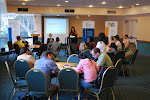 |
| Somebody Else's Snarling Pet Dog |
A recent article in the Santa Rosa Press Democrat was
titled “Fake Service Dogs Anger Owners of Trained Pets”.
As the
proud partner of a “Trained Pet” named Presto, please ignore the head banging.
How many times have I snarled, “He is not a PET,” to an airline
reservationist? I was dismayed by this news. That is to say, I was
dismayed that the issue made the news. I was not looking forward to
another day of explaining myself as I went about my daily activities with my
Pet (Trained) by my side.
Most of us who use Guide Dogs or Service Dogs have
experienced access challenges of one sort or another. I have had cab drivers
holler, “No mutts lady!” as they screech away from the curb when I attempt to
hop in. I have had bus drivers refuse to move their buses and customer service
people refuse to serve me. Mothers drag their small children towards Presto on
a regular basis, cooing, “Loooook, doggie, “ and offering little hands as a
succulent treat that fortunately Presto ignores (unless they’ve been eating
bacon).
Usually (with the possible exception of cab drivers), an
explanation that my dog is a “Service Dog” will get the bus moving. But
recently, publicity about “fake service dogs” have brought out the worst in
people. For example, a couple of weeks ago I boarded the campus shuttle with
Presto only to be stopped at the door by the driver. “You got papers for that
dog?” she growled. I pointed to his vest and gave my Service Dog spheel. “I
need papers,” said the driver again. I explained about my disability. I told
the driver about the work Presto does for me. I explained about the ADA (I was
on a roll) but the driver would not give up. She did finally move the bus, but
she publically humiliated me during the entire ride by continuing to assert my
illegitimacy in a loud voice and arranging over the radio for security to meet
me upon my disembarkment. I am sure I was the most exciting thing that
had happened to her all month. There had recently been a news story about “fake
service dogs” in our local paper. And I paid for it dearly.
After I spotted the “Trained Pets” story I became curious. Just how many people out there are actually trying to scam us into believing their mutts are the genuine article? A search for “fake service dogs” led to little data but some interesting commentary.
According to a blog called “Life with Dogs”:
 |
| Image from website where "service dog" ID can be ordered. |
“The New York Post reported that many New Yorkers have been using fake ‘service dog’ tags on their pets so they can take them wherever they want. Dog owners in New York have been purchasing fake tags, vests, patches and certificates on the internet. These New Yorkers put these tags on their dogs so they can take them into restaurants, grocery stores, coffee shops, clubs and other business.” (http://www.lifewithdogs.tv/2013/08/people-using-fake-service-dog-tags/)
What is the matter with these
people? Why on earth would anyone want to take their dog to the grocery store?
It’s like taking a child to the grocery store, distractions around every corner.
And a club?? What dog would not go absolutely insane inside a club with blaring
music and stupid dancing drunk people? Cafe’s, coffee shops and restaurants, I
guess if you’re a Francophile. But honestly, if Presto did not perform a
functional service for me, I would leave him at home asleep on my couch,
chewing on one of my daughter’s Barbie shoes, where he belongs.
Apparently, some people are so
into their dogs that they will break the law to go everywhere with them.
Service Dogs Central has an article on “Spotting Fake Certification” with a
long list of online sites where you can purchase phony Service Dog
certification and equipment. They also feature “scary” verbiage from these
sites including (very scary) tidbits such as:
"If
your dog exhibits occasional nipping, Service Dog Certification of America
recommends muzzling." (http://servicedogcentral.org/content/node/509)
 |
| Dog eating waffle off plate in cafe. |
Today a
CBS news story about fake service dogs made the national news:
“It's an easy law to break,
and dog cheats do. By strapping a vest or backpack that says ‘service animal’
to their pet, anyone can go in stores and restaurants where other dogs are
banned, creating growing problems for the disabled community and business
owners and leading to calls for better identifying the real deal.”(http://www.cbsnews.com/8301-204_162-57607109/illegal-fake-service-dogs-pose-dangers-to-many/)
 |
| Dog sitting on couch with feathers from pillow all around. |
As I stood in line at Starbucks with Presto, waiting to
order my afternoon-slump latte, not one but two little old ladies gave
me the stink eye. “Cheater,” their looks said. I gave them the stink eye right
back, but it did bother me. I have the vest, the leash, the ID tag and the ID
card, all proclaiming that Presto is a genuine Service Dog. He even looks
like a service dog (Golden Retriever with impeccable manners). What do I need
to do to “prove it” to these people? Just because Lazy Larry doesn’t want to
leave his dog at home so he doesn’t have to worry about his carpet shouldn’t
mean that someone with a disability has to submit a blood test to use public
transportation with their Service Dog. How about prosecuting people who sell fake
ID cards? How about “Three Piddles and You’re Out”?











